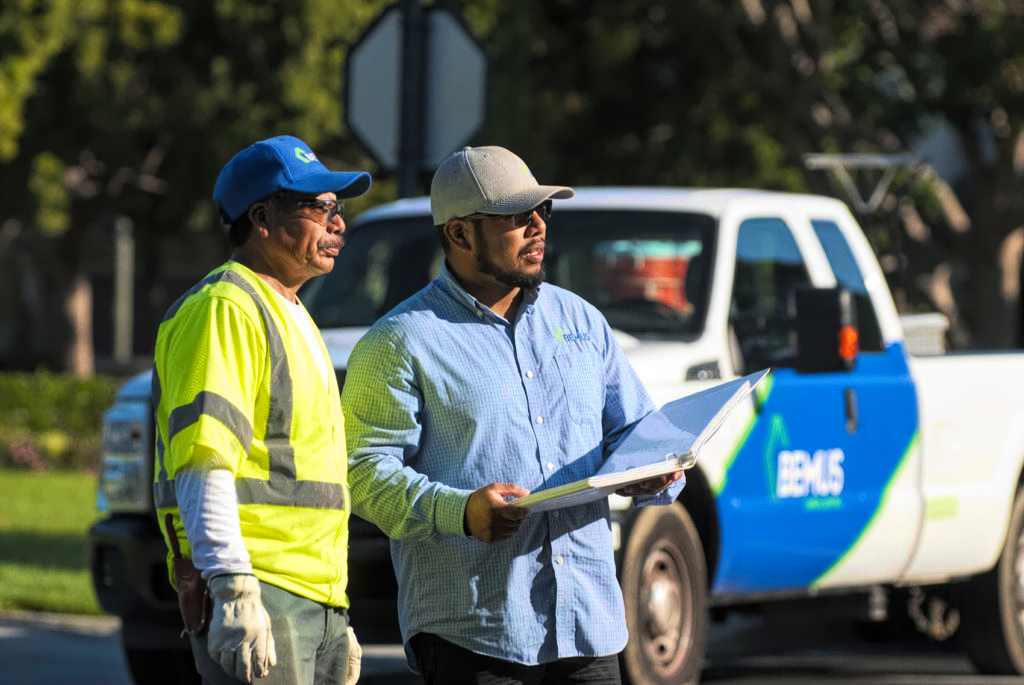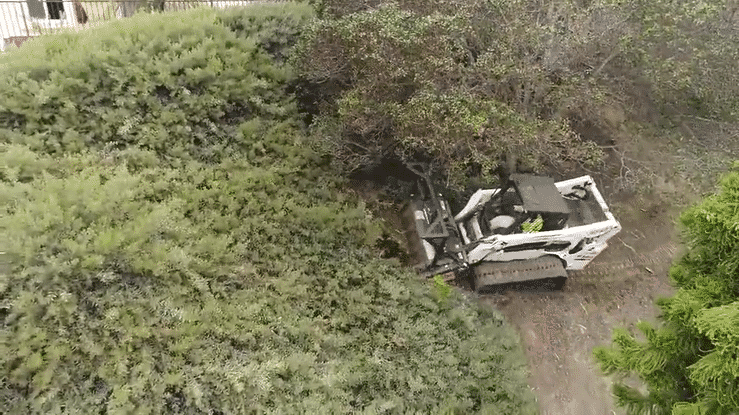Brush Management & Erosion Control Services
At Bemus Landscape, we understand the critical importance of proactive brush management and erosion control in maintaining your property’s safety, beauty, and ecological health. Our skilled team offers comprehensive solutions to reduce wildfire risk, manage overgrown vegetation, and prevent soil loss in Southern California’s dynamic landscape.
Our strategic brush management services create defensible space around your buildings, reducing the risk of wildfire spread and intensity.
Through a careful process of thinning, pruning, and removals, we improve firefighters’ access, making it easier to protect your property in an emergency.
As one of a select few companies to hold a Brush Management License from the California Contractors State License Board, we have the expertise to ensure compliance with all local fire codes and regulations.



Most Popular Questions
What is an overview of your primary services for Brush Management Services?
Following is a brief overview of the Brush Management Services provided by Bemus Landscape:
– Fuel reduction and thinning of overgrown vegetation
– Selective pruning and removal of dead, diseased, or hazardous trees and shrubs
– Creation and maintenance of defensible space around buildings and structures
– Brush clearance and fire break installation in compliance with local fire codes
– Debris removal and proper disposal of cut vegetation
– Fuel moisture monitoring and wildfire risk assessment
– Coordination with local fire departments and emergency services
– Post-fire restoration and landscape recovery services
Additional Features:
– Expertise in Southern California’s unique ecology and microclimates
– Use of eco-friendly, non-toxic, and biodegradable erosion control products
– Integration of native and drought-tolerant plants for long-term stability
– Specialized equipment for working in difficult terrain and sensitive habitats
– Certified and experienced team of brush management and erosion control professionals
– Commitment to sustainable practices and environmental stewardship
– Collaborative approach working with property owners, managers, and local authorities
– Comprehensive insurance coverage and liability protection for clients
– Flexible scheduling and rapid response to emergencies or time-sensitive projects
– Ongoing education and training to stay current with industry best practices and regulations
What is an overview of your primary services for Erosion Control Services?
Below is a brief overview of the primary services for Erosion Control from Bemus Landscape:
– Comprehensive site evaluation and soil analysis
– Customized erosion control planning and design
– Slope stabilization and grading services
– Installation of erosion control blankets, wattles, and silt fences
– Hydroseeding and drill seeding for rapid vegetation establishment
– Application of mulch, compost, and soil amendments to improve soil structure
– Stormwater management and drainage system installation
– Streambank and shoreline stabilization solutions
– Monitoring and maintenance of erosion control measures
-Permit acquisition and regulatory compliance assistance
What are some strategies to consider in brush management planning for properties in Southern California?
When planning brush management for properties in Southern California, several key strategies should be considered to effectively reduce wildfire risk, promote ecological health, and ensure compliance with local regulations.
These include:
Create defensible space – Establish clear zones around structures where vegetation is thinned, pruned, or removed to reduce fuel loads and create a buffer against wildfire spread. The size and composition of these zones may vary based on local fire codes and property-specific factors.
Prioritize high-risk areas – Focus brush management efforts on areas with the highest wildfire risk, such as slopes, canyons, and areas adjacent to wildlands or open spaces. These areas may require more frequent or intensive treatments to maintain safety.
Use a mosaic approach – Rather than clearing all vegetation, use a mosaic or patchwork approach that creates a mix of open spaces and vegetated areas. This helps maintain ecological diversity, prevent soil erosion, and provide habitat for wildlife.
Select fire-resistant plants – When landscaping within defensible space zones, choose plants with low fuel volume, high moisture content, and deep root systems that help retain soil. Native, drought-tolerant species are often well-suited to Southern California’s climate and can help reduce maintenance needs.
Manage vertical and horizontal spacing – Prune trees to maintain vertical separation between the ground and lower branches, reducing the risk of ground fires climbing into the canopy. Maintain horizontal spacing between trees and shrubs to prevent fire from easily spreading across the landscape.
Remove invasive species – Prioritize the removal of invasive, non-native plants that can increase fuel loads, outcompete native species, and alter fire regimes. Replace these with native, fire-resistant alternatives that support local biodiversity.
Implement ongoing maintenance – Develop a regular maintenance schedule to keep vegetation growth in check, remove dead or dying plants, and ensure defensible space remains effective over time. The frequency of maintenance may vary based on the property’s specific needs and local requirements.
Coordinate with neighbors – Work collaboratively with adjacent property owners to create a cohesive, community-wide approach to brush management. Consistent efforts across property lines can greatly enhance the overall effectiveness of wildfire risk reduction strategies.
Integrate with other resource management goals – Consider how brush management strategies can support other property goals, such as erosion control, water conservation, or habitat preservation. An integrated approach can help maximize landscape management’s ecological and economic benefits.
Stay informed and adaptable – Stay current with local fire codes, best practices, and emerging research in wildfire risk reduction. Be prepared to adapt management strategies as conditions change or new information becomes available.
By incorporating these strategies into a comprehensive brush management plan, property owners and managers in Southern California can effectively reduce wildfire risk, promote landscape resilience, and maintain regulatory compliance. Working with experienced professionals who specialize in brush management can help ensure that plans are tailored to each property’s unique needs and challenges.
Who do I contact regarding brush management regulations, permits, and standards?
In Southern California, brush management regulations, permits, and standards are typically overseen by local government agencies, often at the county or municipal level.
Following are some key contacts you may need to reach out to for information and guidance:
Local Fire Department: Local fire departments enforce many brush management regulations, especially in areas prone to wildfires. Contact your local fire department to inquire about brush management requirements, permits, and standards applicable to your property.
County or City Planning Department: Your county or city planning department may also regulate brush management practices. They can provide information on zoning ordinances, land use regulations, and permit requirements related to brush clearance and vegetation management.
County Agricultural Commissioner’s Office: In some cases, the county agricultural commissioner’s office may be involved in overseeing brush management regulations, particularly in rural or agricultural areas. They can provide information on pest control measures and regulations related to vegetation management.
Regional Water Quality Control Board: If your property is near water bodies or within designated watershed areas, you may need to comply with regulations enforced by the regional water quality control board. They can provide guidance on erosion control measures, sedimentation prevention, and habitat protection requirements.
California Department of Forestry and Fire Protection (CAL FIRE): CAL FIRE is the state agency responsible for wildfire prevention and protection. While their focus is primarily on large-scale fire management, they may provide resources and guidance on brush management practices and regulations.
Local Homeowners’ Association (HOA): If you live in a planned community or development with an HOA, they may have specific guidelines and regulations related to brush management and landscaping. Consult your HOA documents or contact the HOA board for information.
When contacting these agencies or organizations, be prepared to provide details about your property location and size and specific questions or concerns related to brush management. They can offer guidance on compliance with regulations, obtaining permits, and implementing best practices for vegetation management to reduce fire risk and protect the environment.
Areas of Expertise
Residential
HOAs, Master Planned Communities, Multi-Family Residential, Military House
Office
Commercial offices, Corporate Campuses, Industrial Facilities, Creative Office Spaces
Medical
Hospitals, Medical Centers, Rehabilitation, MOBs, Acute Care Centers
EDUCATION
Colleges, Universities, K-12 Schools
Recreation
Parks and Civic Spaces, Golf Courses, Museums, Theme Parks Complexes and Fields
Retail
Retail and Lifestyle Centers, Shopping Malls, Mixed Use Developments
Hospitality
Hotels, Destination Resorts, Country Clubs, Theme Parks
Religion
Places of Worship, Cemeteries
Areas of Service
The areas highlighted in green represent the service areas for Bemus Landscape.




